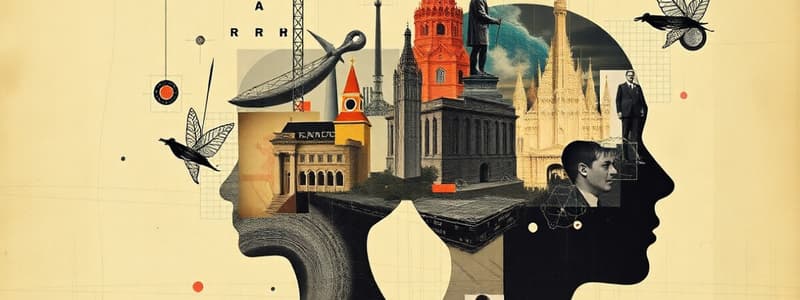Podcast
Questions and Answers
What is the estimated percentage of the population that has a predominantly logical-mathematical learning style, according to Howard Gardner’s theory of Multiple Intelligences?
What is the estimated percentage of the population that has a predominantly logical-mathematical learning style, according to Howard Gardner’s theory of Multiple Intelligences?
- 15-20%
- 5-10% (correct)
- 25-30%
- 40-45%
Compared to their peers, students with a logical learning style tend to score how much higher on standardized math tests?
Compared to their peers, students with a logical learning style tend to score how much higher on standardized math tests?
- 15-20% higher (correct)
- 10-15% higher
- 5-10% higher
- 25-30% higher
In a study of high school students, what percentage of logical learners were more likely to pursue STEM careers compared to other learning styles?
In a study of high school students, what percentage of logical learners were more likely to pursue STEM careers compared to other learning styles?
- 30% (correct)
- 20%
- 25%
- 15%
How much faster do logical learners typically process information when it's presented in a structured, sequential manner?
How much faster do logical learners typically process information when it's presented in a structured, sequential manner?
What percentage of individuals identified as logical learners prefer to work independently rather than in groups?
What percentage of individuals identified as logical learners prefer to work independently rather than in groups?
Compared to other learning style groups, logical learners are how much more likely to enjoy puzzle-solving activities?
Compared to other learning style groups, logical learners are how much more likely to enjoy puzzle-solving activities?
Logical learners spend on average how much more time analyzing problems before attempting to solve them?
Logical learners spend on average how much more time analyzing problems before attempting to solve them?
What percentage of logical learners report a preference for non-fiction reading materials over fiction?
What percentage of logical learners report a preference for non-fiction reading materials over fiction?
What percentage of individuals identified as logical learners report a strong preference for step-by-step instructions?
What percentage of individuals identified as logical learners report a strong preference for step-by-step instructions?
Approximately what percentage of logical learners prefer visual aids like charts and graphs compared to text-only presentations?
Approximately what percentage of logical learners prefer visual aids like charts and graphs compared to text-only presentations?
Flashcards
Logical Learning Style
Logical Learning Style
A learning approach that uses logic, order, and sequential steps to understand and solve problems.
Logical Learners
Logical Learners
Individuals who prefer to learn through logic, patterns, and systematic approaches.
Prevalence of Logical Learners
Prevalence of Logical Learners
Approximately 5-10% of the population, as per Howard Gardner’s theory.
Logical Learners and Math Scores
Logical Learners and Math Scores
Signup and view all the flashcards
Logical Learners and STEM
Logical Learners and STEM
Signup and view all the flashcards
Information Processing Speed
Information Processing Speed
Signup and view all the flashcards
Preference for Independent Work
Preference for Independent Work
Signup and view all the flashcards
Problem Analysis Time
Problem Analysis Time
Signup and view all the flashcards
Reading Preferences
Reading Preferences
Signup and view all the flashcards
Preference for Instructions
Preference for Instructions
Signup and view all the flashcards
Study Notes
- Logical learning involves using logic, order, and steps to solve problems.
- Logical learners are good with numbers, systematic, and organized.
- They enjoy learning through patterns, relationships, and categorization.
Key Statistics
- According to Howard Gardner’s theory of Multiple Intelligences, approximately 5-10% of the population has a predominantly logical-mathematical learning style.
- Students with a logical learning style tend to score 15-20% higher on standardized math tests compared to their peers.
- 30% more logical learners are likely to pursue STEM careers, according to a study of 1000 high school students.
- When information is presented in a structured, sequential manner, logical learners process it 25% faster.
- 60% of individuals identified as logical learners prefer to work independently rather than in groups.
- Logical learners are 40% more likely to enjoy puzzle-solving activities compared to other learning style groups.
- 45% of 500 teachers surveyed reported logical learners ask more "why" questions than other students.
- Logical learners spend approximately 30% more time analyzing problems before attempting to solve them.
- Students with a logical learning preference are 20% more likely to excel in computer programming courses.
- 70% of logical learners prefer non-fiction reading materials over fiction.
- Logical learners use categorization and classification techniques 50% more often than other learners in a study of learning strategies.
- When information is presented in a cause-and-effect format, logical learners typically retain 25% more.
- 80% of individuals identified as logical learners prefer step-by-step instructions.
- Logical learners are 35% more likely to create their own study systems or mnemonics to remember information.
- Those who identified as logical learners reported 40% higher job satisfaction in careers that involve problem-solving and analysis in a survey of 1000 adults.
- Logical learners typically score 10-15% higher on tests that involve pattern recognition compared to other learning style groups.
- 55% of logical learners prefer visual aids like charts and graphs over text-only presentations.
- Students with a logical learning style are 25% more likely to excel in subjects like physics and chemistry.
- Planning and organizing tasks takes 40% more time for logical learners compared to other learning styles.
- Logical learners were 30% more likely to participate in math or science competitions, in a study of 2000 students.
- 65% of logical learners prefer objective, fact-based discussions over subjective or emotion-based ones.
- Logical learners are 20% more likely to use calendars and to-do lists for managing their time and tasks.
- 75% indicated a strong dislike for ambiguity in instructions or explanations, in a survey of learning preferences.
- Students with a logical learning style typically perform 30% better on tasks involving statistical analysis and data interpretation.
- Logical learners are 45% more likely to enjoy strategy-based board games and video games compared to other learning style groups.
- 60% of logical learners prefer online or computer-based learning over traditional classroom settings.
- Logical learners were found to use analogies and metaphors 25% more frequently than other learners, according to a study of problem-solving approaches.
- Logical learners typically score 20% higher on tests of critical thinking and analytical reasoning.
- 70% of individuals identified as logical learners have a strong interest in how things work or are built.
- Logical learners were 40% more likely to create detailed outlines and mind maps when preparing for exams, according to a survey of study habits.
Detailed Statistics
- According to Howard Gardner’s Multiple Intelligences theory, an estimated 5-10% of the population has a predominantly logical-mathematical learning style.
- Logical learners typically perform better in analytical subjects like math, physics, chemistry, biology, and science.
- Logical learners tend to score 15-20% higher on standardized math tests compared to peers.
- Compared to their peers, students with a logical learning style are typically 25% more likely to excel in subjects like physics and chemistry.
- Those who are logical learners are found to perform 30% better on tasks that involve statistical analysis and data interpretation.
- There's a 20% greater chance of excelling in computer programming courses among students who have a logical learning style.
- A recent survey showed that logical learners are 25% more likely to excel in subjects like physics and chemistry.
- 45% of teachers have noticed Logical learners tend to ask more “why” questions than other students.
- Preparing for exams, logical learners were found to be 40% more likely to create detailed outlines and mind maps.
- Logical learners typically spend 40% more time on planning and organizing tasks.
- Information presented in a structured, sequential manner is processed 25% faster
- Approximately 60% of logical learners prefer to work independently rather than in groups.
- Also, they spend 30% more time analyzing problems before attempting to solve them.
- Logical learners are likely to score 20% higher on tests of critical thinking and analytical reasoning.
- Logical learners compared to other learning style groups are 40% more likely to enjoy puzzle-solving activities.
- Approximately 70% of logical learners show a preference for non-fiction reading materials.
- About 80% of logical learners show a preference for step-by-step instructions.
- An estimated 55% of logical learners prefer visual aids like charts and graphs in comparison to text-only presentations.
- Compared to subjective or emotion-based ones, logical learners at around 65% tend to prefer objective and fact-based discussions.
- Logical learners are 20% more prone to use calendars and to-do lists to manage their time and tasks.
- 75% of logical learners demonstrated a strong distaste for ambiguity in instructions or explanations.
- Strategy-based board games and video games are more likely to be enjoyed by logical learners at around 45%.
- An estimated 60% of logical learners report they favor online or computer-based learning over traditional classroom settings.
- Roughly 70% of logical learners report a strong interest in understanding how things work or are built.
- Logical learners tend to score 10-15% higher on pattern recognition tests.
- Logical learners self-reporting were 40% more likely to have higher job satisfaction in careers that involve problem-solving and analysis.
- Categorization and classification strategies in a learning setting were found to be used 50% more often by logical learners.
- Analogies and metaphors are used more frequently, at 25%, by those who prefer logical learning, as opposed to other learners.
Logical Learner Defined
- Logical learning is a style where people process information using logic, order, and steps.
- Logical learners employ logic to process information and understand subjects.
- They excel at math and learn through patterns, statistics, and mathematical equations.
Strategies for Classrooms
- Solving complex math equations.
- Playing chess.
- Coding.
- Conducting scientific experiments.
- Analyzing data in graphs and identifying patterns in sequences.
Advantages
- Logical learners develops strong analytical and problem-solving skills.
- They recognize patterns and trends in data.
- Demonstrate comfort with numbers and data.
- They possess critical thinking ability.
- Make effective decisions.
Disadvantages
- Logical learners are prone to over-analyzing details.
- They face difficulty with creativity.
- They get frustrated with ambiguity.
- They have a limited emotional understanding.
- Have a potential for disengagement in group work
Logical vs other learning styles
- Interpersonal learners learn best through talking and working in groups, possess strong communication skills, collaboration, and adaptability, tend to be vocal and enjoy social activities.
- Intrapersonal or solitary learners gain knowledge best by working alone and reflecting on their own thoughts and experiences.
- Kinesthetic learners use their bodies and sense of touch to learn best.
- Visual learners learn through seeing and often remember best what they see.
- Auditory learners learn when listening to information, whether through lectures, discussions, or audio recordings.
Characteristics of Logical Learners
- A preference for structured information.
- A strong ability to identify patterns.
- A methodical approach to problem-solving.
- A focus on cause-and-effect relationships.
- A love for numbers and data.
- A tendency to think linearly.
Classroom Accommodations
- Teachers can accommodate logical learners by providing activities that involve problem-solving, critical thinking, analysis of patterns, using charts and graphs, and posing open-ended questions that require reasoning.
Studying That Suits You
Use AI to generate personalized quizzes and flashcards to suit your learning preferences.




